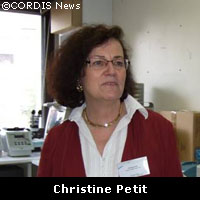EU project gives hope to the deaf and hard of hearing
EU-funded researchers are making great inroads into understanding the genetic causes of hearing loss, paving the way for new diagnostic tools and treatments for the 10% of the EU population that suffers from a hearing impairment. The EuroHear project partners have identified half of the known genes for deafness, and their work is already having an impact on patients with the development of diagnostic tools to identify which gene is causing the problem in a particular individual. More than one child in 1,000 is born deaf, and these children face considerable challenges in learning to speak and read. Many more people suffer from hearing problems as they get older. In total over 40 million Europeans suffer from some form of hearing impairment and two million are profoundly deaf. As Europe's population ages, these figures are likely to get bigger. 'Over 65 years of age, a third of the population is suffering from hearing loss impeding conversational exchanges,' explained project coordinator Professor Christine Petit of the Pasteur Institute. 'This results in social isolation and major depression.' So far there is no cure for hearing impairments, although prostheses such as hearing aids and cochlear implants are able to improve the hearing of many people. The goal of the EuroHear project is to identify the genes involved in both early and late onset hearing impairment; to understand the mechanisms behind both normal and impaired hearing; and to develop tools to prevent and cure hearing impairment. At the heart of the EuroHear project is the cochlea, a tightly coiled structure which lies deep in the inner ear. The cochlea contains thousands of 'hair cells', which are responsible for converting sounds into electrical signals which are then sent along nerve cells to the brain. 'We are born with a certain number of hair cells and once we lose them we no longer have the capacity to develop new ones,' explains project co-coordinator Professor Karen Avraham of Tel Aviv University. In other words, when a hair cells dies, it is gone forever. Thanks to the EuroHear project, scientists now have a better understanding of how the different compartments of these hair cells operate and the molecules involved in turning sounds into electrical signals. In total the team has discovered 12 new genes for deafness. Most of these affect the cochlea in some way, but one of the genes identified causes a defect in the nerve cells of the central nervous systems which are responsible for processing the information coming from the cochlea. The researchers have already developed diagnostic tools to identify which genetic mutation is causing a patient's hearing problems. This is important because it can help doctors decide if a deaf child will benefit from a cochlear implant. In short, for a cochlear implant to work, the auditory nerve must be intact. This means that if a patient has a mutation which affects only the cochlea, the child will likely benefit from a cochlear implant. On the other hand, if the child's deafness is due to a mutation affecting the auditory nerve, an implant will not be useful. The project partners have put together information on the genetics behind hearing impairments to help families affected by deafness understand what is going on. These have been translated into a number of languages. The scientists are also looking to develop treatments for hearing problems. 'On the basis of our findings of the functional connections between several deafness genes, we are now in a position to identify possible targets for therapies, common to several deafness forms,' said Prof Petit. The EuroHear project unites 250 scientists from 22 laboratories and three small-to-medium sized enterprises (SMEs) in ten countries. The success of the project is due to its multidisciplinary approach; it brings together physicians, geneticists, cell biologists, biochemists, electrophysiologists and physicists. Patient groups are also closely involved in the project work, and are a major source of DNA samples which are clearly a vital ingredient in the hunt for deafness genes. A total of €12.5 million of the project's €15.8 million budget comes from the Sixth Framework Programme's 'Life sciences, genomics and biotechnology for health' thematic area. The project started in 2005 and will run until 2009.



